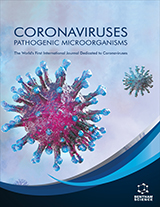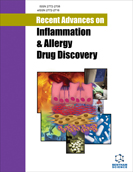Abstract
TNF-related apoptosis inducing ligand (TRAIL) is a key mediator of the innate immune response to infection. While TRAIL-mediated apoptosis plays an essential role in the clearance of virus-infected cells, its physiologic role also includes immunosurveilance for cancer cells. Therapeutics that induce TRAIL-mediated apoptosis in cancer cells remain a focus of ongoing investigation in clinical trials, and much has been learned from these studies regarding the efficacy and toxicity of these interventions. These data, combined with data from numerous preclinical studies that detail the important and multifaceted role of TRAIL during infection with human immunodeficiency virus and other viruses, suggest that therapeutic exploitation of TRAIL signaling offers a novel and efficacious strategy for the management of infectious diseases.
Keywords: Infectious Diseases, TNF, apoptosis, ligand (TRAIL), cancer cells
Anti-Infective Agents in Medicinal Chemistry
Title: The Biology of TRAIL and the Role of TRAIL-Based Therapeutics in Infectious Diseases
Volume: 8 Issue: 2
Author(s): Brett D. Shepard and Andrew D. Badley
Affiliation:
Keywords: Infectious Diseases, TNF, apoptosis, ligand (TRAIL), cancer cells
Abstract: TNF-related apoptosis inducing ligand (TRAIL) is a key mediator of the innate immune response to infection. While TRAIL-mediated apoptosis plays an essential role in the clearance of virus-infected cells, its physiologic role also includes immunosurveilance for cancer cells. Therapeutics that induce TRAIL-mediated apoptosis in cancer cells remain a focus of ongoing investigation in clinical trials, and much has been learned from these studies regarding the efficacy and toxicity of these interventions. These data, combined with data from numerous preclinical studies that detail the important and multifaceted role of TRAIL during infection with human immunodeficiency virus and other viruses, suggest that therapeutic exploitation of TRAIL signaling offers a novel and efficacious strategy for the management of infectious diseases.
Export Options
About this article
Cite this article as:
Shepard D. Brett and Badley D. Andrew, The Biology of TRAIL and the Role of TRAIL-Based Therapeutics in Infectious Diseases, Anti-Infective Agents in Medicinal Chemistry 2009; 8 (2) . https://dx.doi.org/10.2174/187152109787846060
| DOI https://dx.doi.org/10.2174/187152109787846060 |
Print ISSN 1871-5214 |
| Publisher Name Bentham Science Publisher |
Online ISSN 1875-6018 |
 9
9Related Articles
-
Angiotensin II Type 1 Receptor Antagonist as an Angiogenic Inhibitor in Urogenital Cancer
Reviews on Recent Clinical Trials Interaction and Structural Modification of Topoisomerase IIα by Peptidyl Prolyl Isomerase, pin1: An In Silico Study
Protein & Peptide Letters Lipid Nanocarriers for Neurotherapeutics: Introduction, Challenges, Blood-brain Barrier, and Promises of Delivery Approaches
CNS & Neurological Disorders - Drug Targets An Expanding Appreciation of the Role Chemokine Receptors Play in Cancer Progression
Current Pharmaceutical Design Recent Approaches for Studying the Role of Glia
CNS & Neurological Disorders - Drug Targets Glioblastoma Multiforme and its Cell Interruption
Current Cancer Therapy Reviews Persistent Current Blockers of Voltage-Gated Sodium Channels: A Clinical Opportunity for Controlling Metastatic Disease
Recent Patents on Anti-Cancer Drug Discovery Advanced Vectors for Gene Delivery
Current Drug Therapy Interpreting the Mechanisms by which Integrins Promote the Differentiation of Mesenchymal Stem Cells and Integrin Application Prospects
Current Stem Cell Research & Therapy MicroRNAs as Diagnostic, Prognostic and Predictive Biomarkers of Ovarian Cancer
Recent Patents on Biomarkers Erythropoietin in Stroke Therapy: Friend or Foe
Current Medicinal Chemistry Cellular Targets for Anticancer Strategies
Current Drug Targets Recent Advances on Small-Molecule Survivin Inhibitors
Current Medicinal Chemistry Targeting p73 - a Potential Approach in Cancer Treatment
Current Pharmaceutical Design Druggable Orthosteric and Allosteric Hot Spots to Target Protein-protein Interactions
Current Pharmaceutical Design Curcumin Nanomedicine: A Road to Cancer Therapeutics
Current Pharmaceutical Design Prognostic and Therapeutic Implications of MicroRNA in Malignant Pleural Mesothelioma
MicroRNA Therapeutic Use of Chemokines
Current Pharmaceutical Design The Ever Changing Treatments for Tumors of the Central Nervous System
Current Cancer Therapy Reviews The Adenine Nucleotide Translocase 2, a Mitochondrial Target for Anticancer Biotherapy
Current Drug Targets






















